A Wader Spectacular tour today. It has not been much of a summer and today was no exception – the weather was cool and windy, a cold NNW gusting up to 40mph in the morning, with occasional showers. At least we managed to dodge most of the rain and didn’t get too wet, and we made the most of the bright and sunny intervals to have a good day out and enjoy the waders.
We made our way up to the Wash early this morning, to catch the tide, and it was very blustery when we got out onto the seawall. A Turtle Dove flew across the Pit behind us and appeared to go down into the bushes on the bank, but we couldn’t see it from where we were standing. There was still quite a lot of mud uncovered by water, but the tide was coming in extra fast backed by the wind today. There weren’t many birds gathered on the closer mud up towards the sailing club this morning – we could see a large dark oily slick of Oystercatchers further out in the middle and a smaller tight flock of Knot in front of them, but not as many Knot as we were expecting.
We started by looking through the smaller waders down on the mud in front of us. There were lots of Ringed Plover and Sanderling hiding down in the rocks, the latter in a mix of silvery grey winter and darker breeding plumages, and a few Dunlin and Turnstone beyond, some still sporting bright rusty patches in their upperparts. A Little Stint dropped in very briefly but unfortunately flew off again before we could get the scope on it.

There were terns out on the mud too and we got the scope on a group including several Sandwich, Common and Little Terns all together, a nice size comparison before they took off and flew further down, ahead of the rising water. A couple of adult Mediterranean Gulls flew past, showing off their white wing tips. Groups of Dunlin started to fly in off the Wash right over us now, so close we could hear the beating of their wings over the wind, and dropped down over the bank behind, heading in to the Pit to roost already.
A much larger flock of waders came up from further out around the Wash now – the Knot had been hiding further round. They twisted and turned, making various different shapes in the air – perhaps there was a raptor having a go at them, or they were just nervous in the wind – before they gradually settled down again over on the far edge of the saltmarsh.
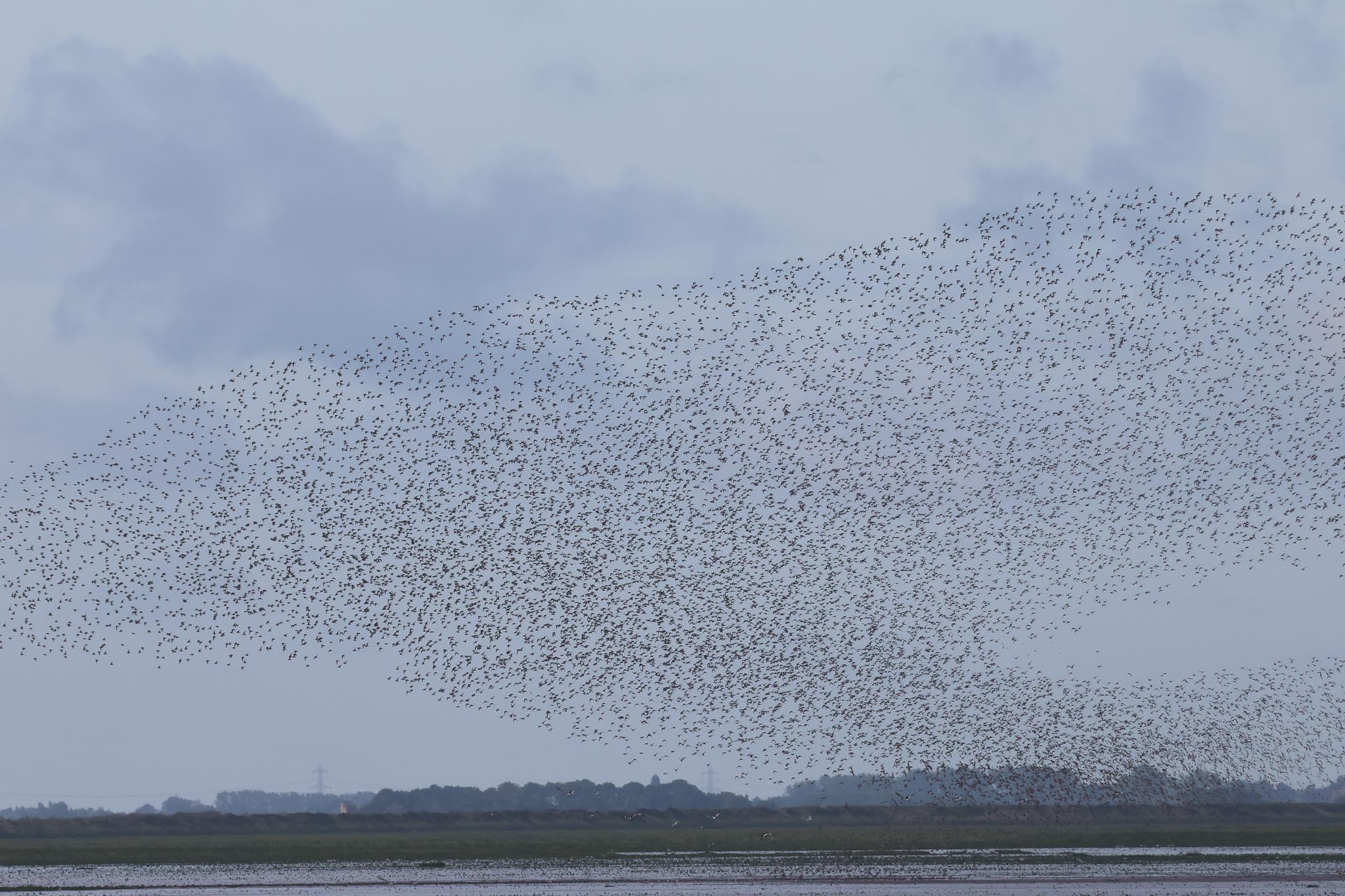
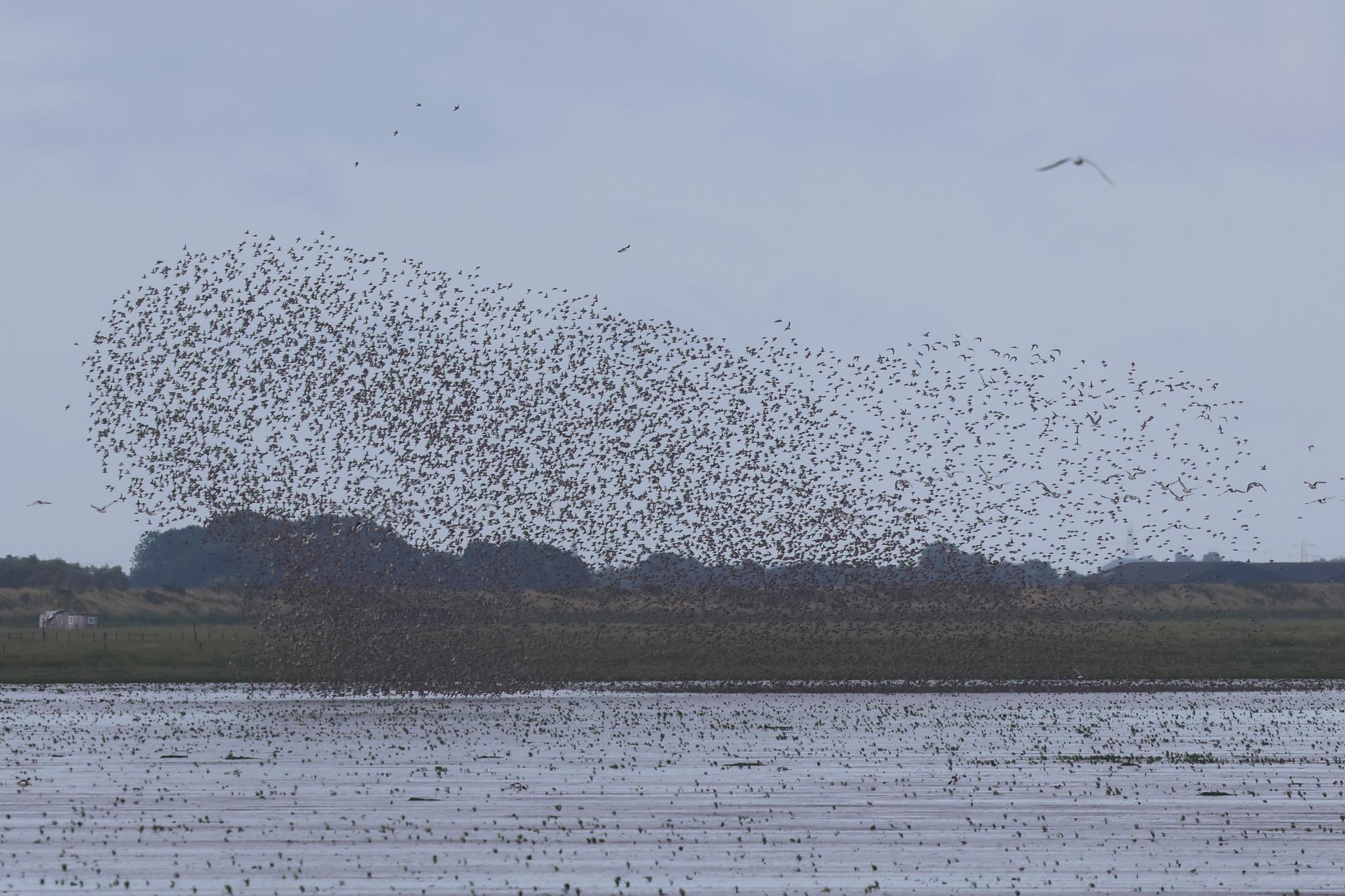
The mud in front of us was quickly covered with water, so we continued on further down towards Rotary Hide. The Turtle Dove flew round over the Pit in front of us and disappeared down below the bushes on the bank again. We couldn’t see it though and then it flew again, out over the water before disappearing off back towards the car park. We could see quite a few Shelduck now out on the water, probably birds which had gathered here on the Wash to moult.
There were lots more Sanderling and Ringed Plover on the edge of the mud and several Oystercatchers sheltering from the wind behind the tufts of vegetation along the shore. Two leucistic juvenile Oyctercatchers really stood out, creamy straw coloured, their bills not yet fully grown.
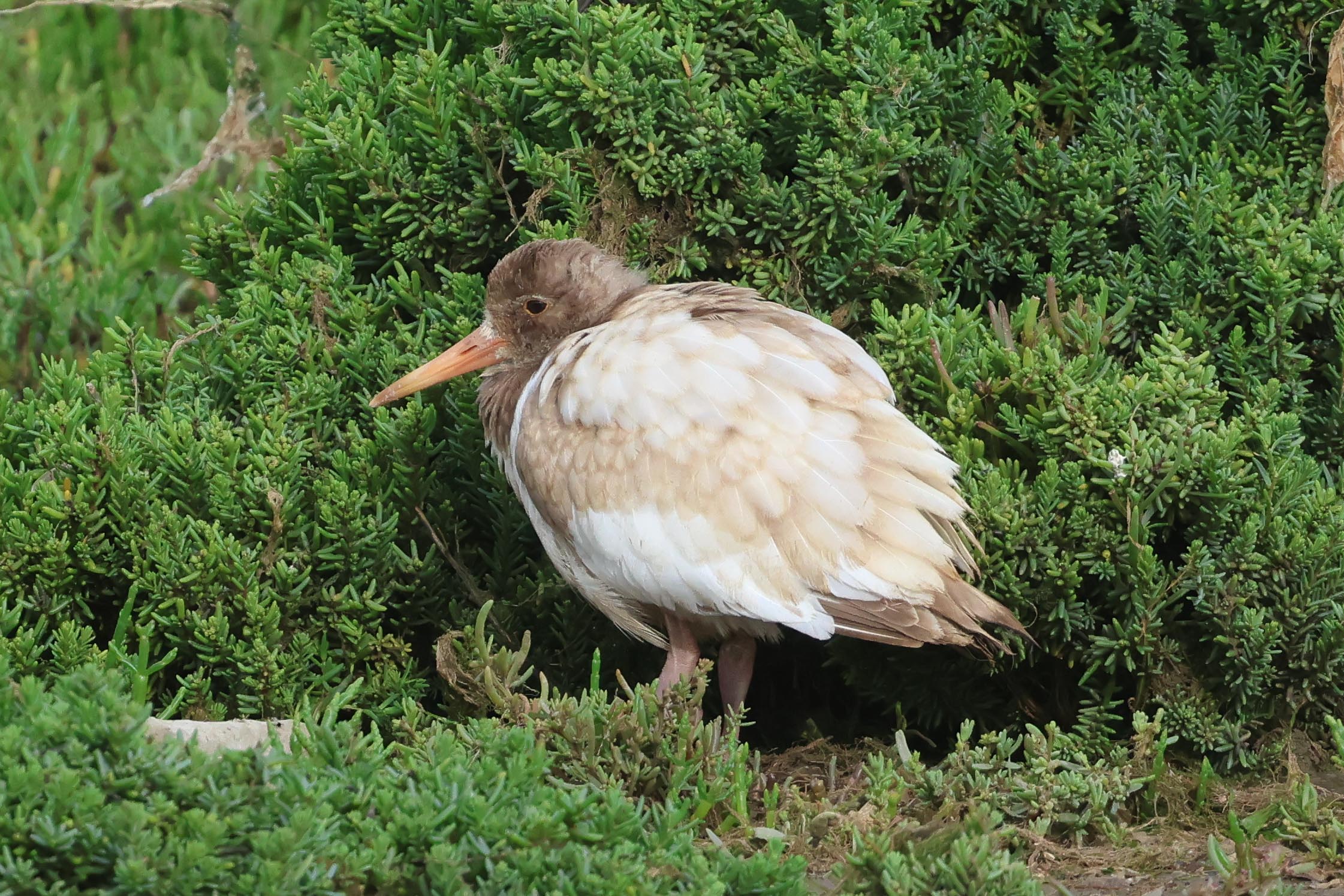
The tide had reached the waders again now. Rather than walking up away from the rising water as they normally do, the Oystercatchers flew up in lines and landed up in the corner by the saltmarsh. The Knot peeled up in groups from the water’s edge too, flying over the bulk of the flock and landing again on the drier side. Something spooked them again, and they flew up, thousands in the air together – apparently the count was up to 32,000 in the last couple of days, as always a very impressive sight – but they quite quickly settled back down on the mud.
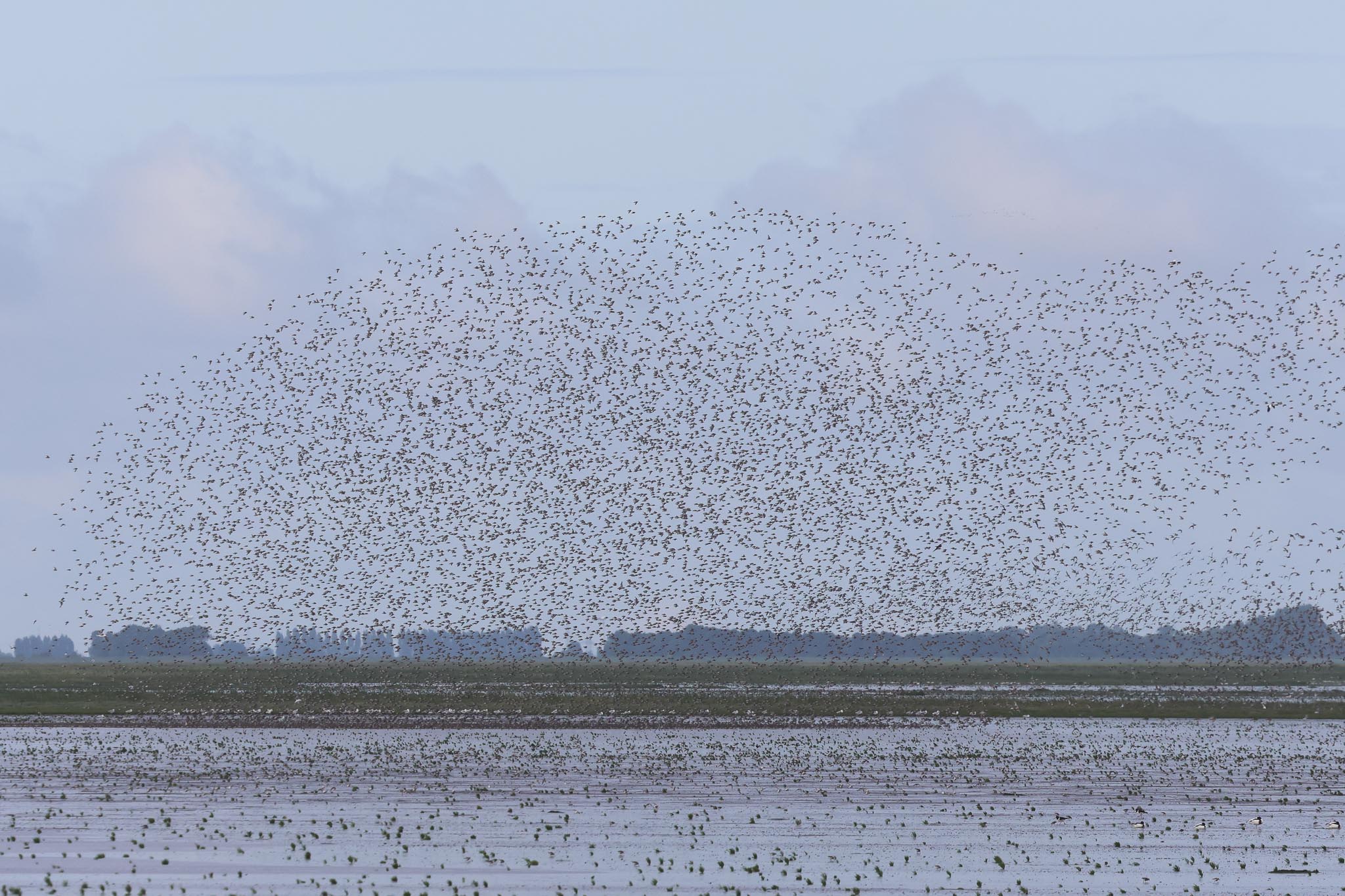

The tide was coming in very fast now, so we set off to walk down to the end. It was a struggle to keep up with the rising water today, so we had to walk quite quickly, and then we positioned ourselves down on the edge of the Wash where the birds were already being squashed into the final corner of the mud which had not been covered. The Oyctercatchers were gathered closer to us, in among the tufts of vegetation, shifting nervously and walking up higher, with quite a few Curlew in the thicker vegetation just beyond. The Knot were packed tightly on the open mud further back.
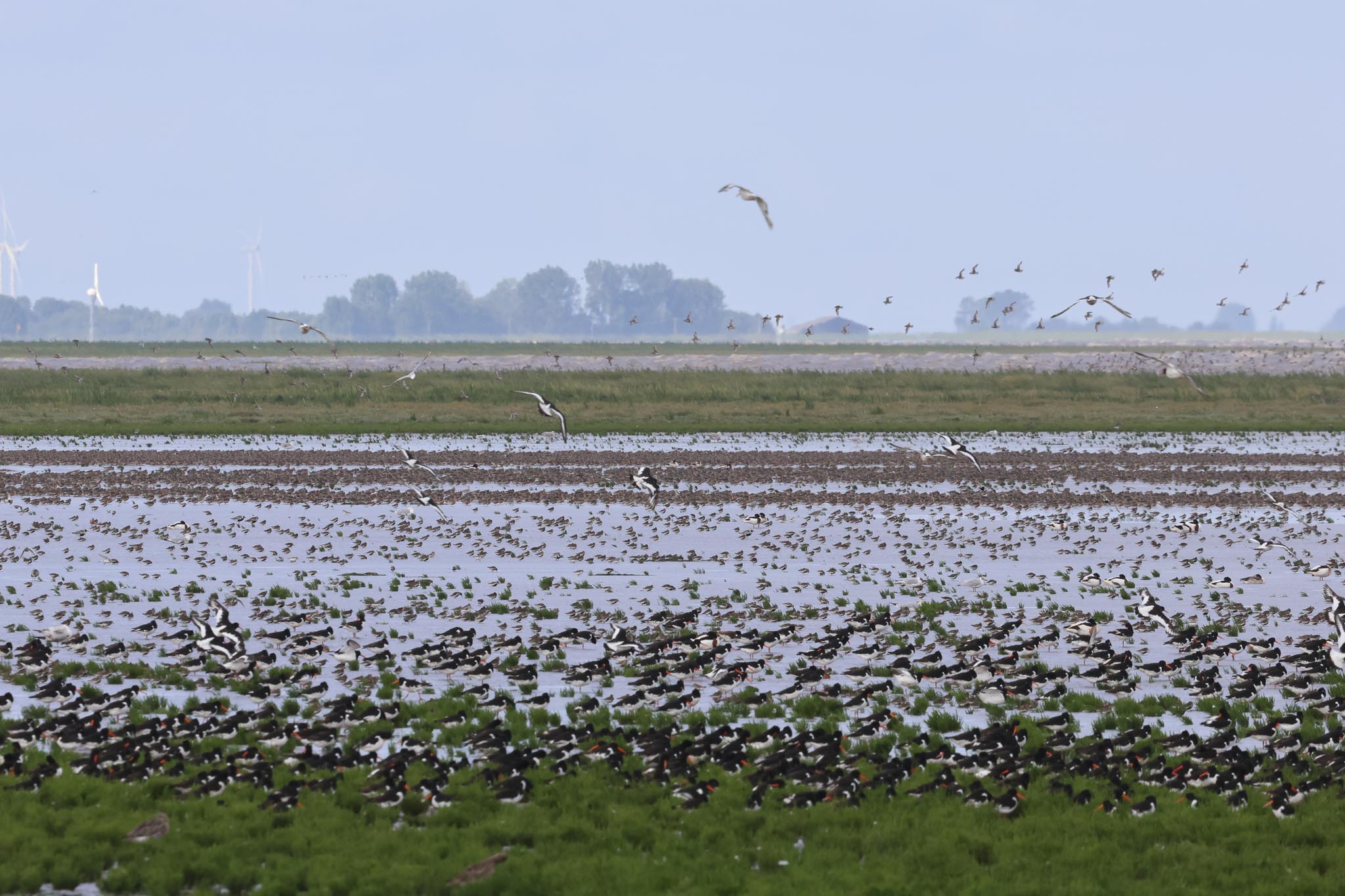
The Oystercatchers started to give up first, coming up from the Wash in lines and flying in overhead, piping noisily. Small flocks of Dunlin came flying in too next, low towards us over the water, looking like they might almost have to fly between us at times, before banking and heading off north along the beach. Finally the Knot gave in to the inevitable and began to fly up in huge waves, flying in right over our heads at first, where we could see the orange bellies of the larger Knot and the black belly patches of the smaller Dunlin mixed in with them.
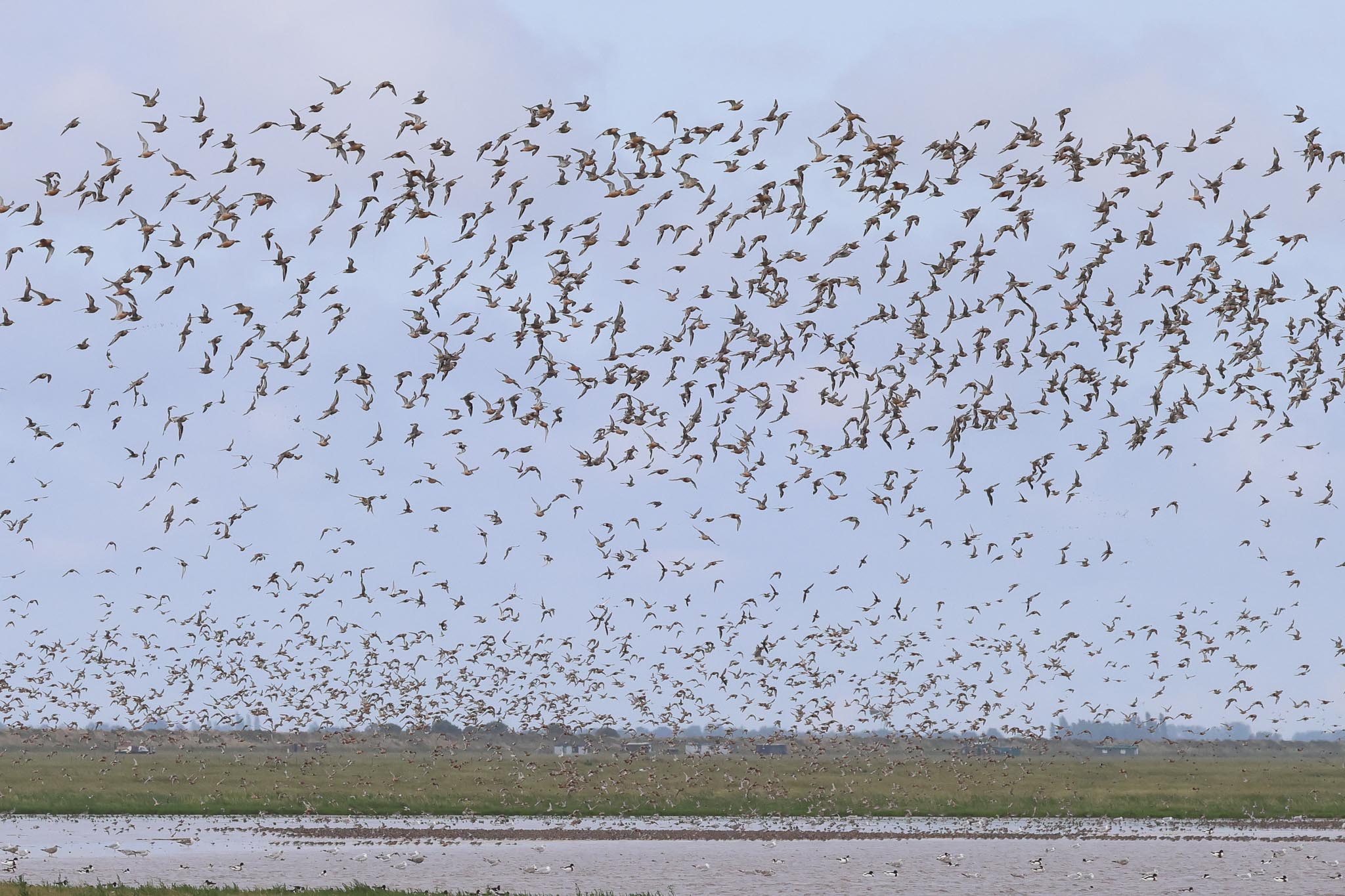
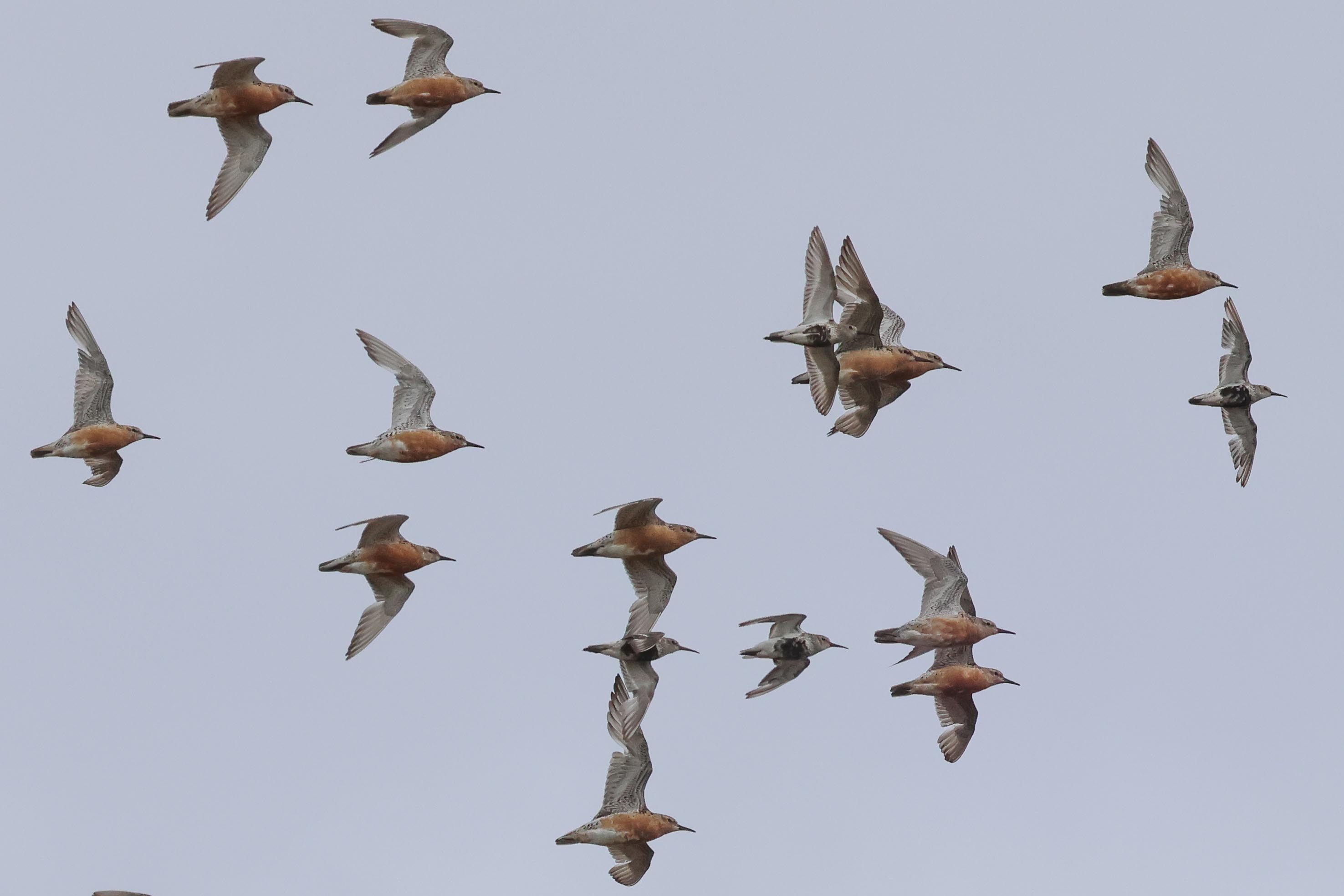
More waves of Knot came up, thousands at a time, and flew in away to our left, turning into the wind and dropping down towards the Pit. We turned to watch them dropping down behind us, but with the sheer volume of birds trying to come in at the same time, the air space was very congested now.
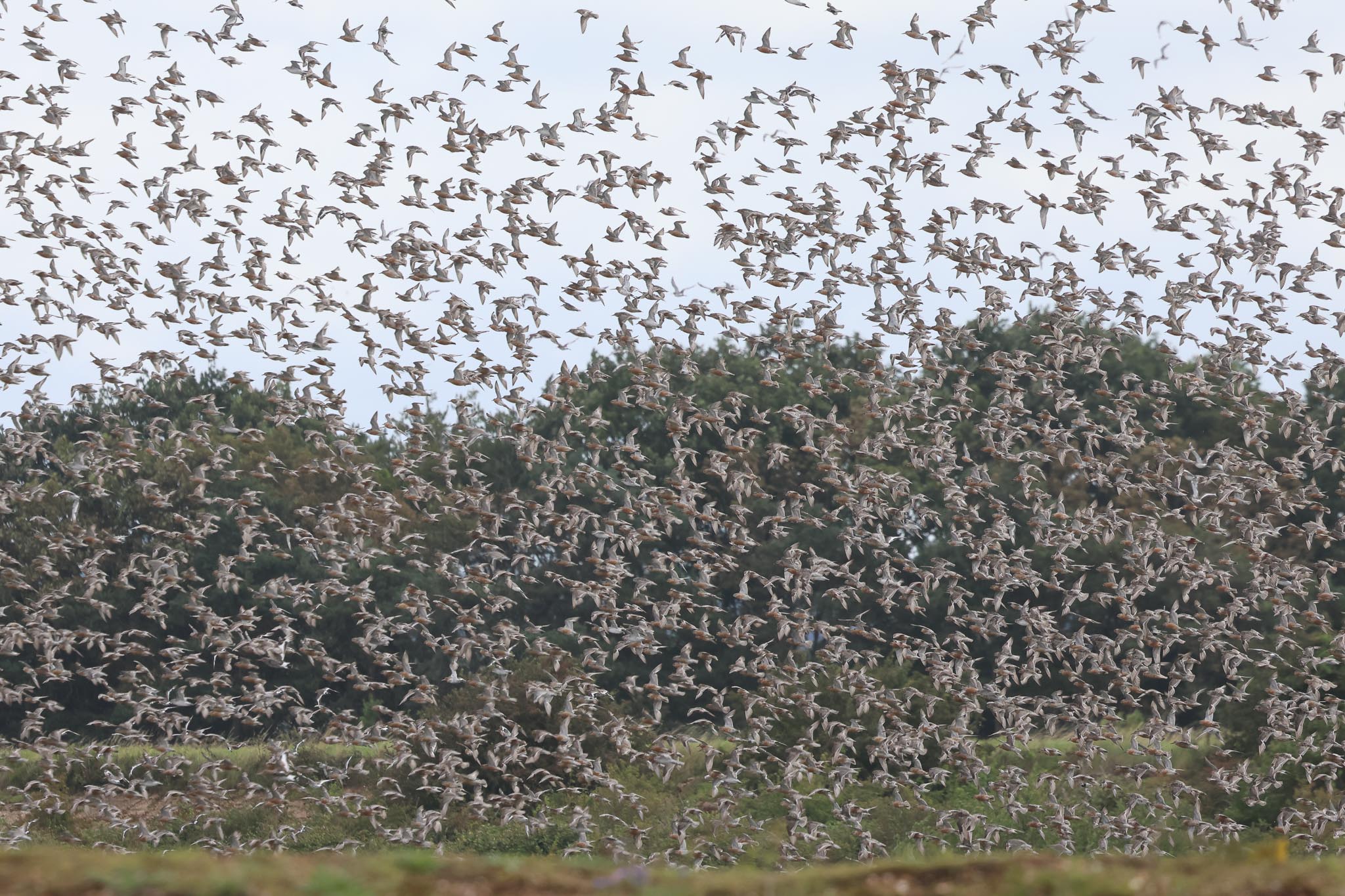
It was made even worse because the birds all seemed very nervous today, possibly because of the wind, and would not settle. Time and again, the Knot which had already gone down on the Pit flew up again in a whirling maelstrom of birds. There were so many Knot in the air there was nowhere to go for the later arrivals, so they circled over the Pit before several large flocks gained height and headed back out high over the Wash. Quite a spectacle!

Eventually all the Knot had left the Wash and the last of the mud was covered. Those that could fit gradually spiralled down and disappeared behind the bank, onto the islands in the Pit. Lots of people had made a beeline for Shore Hide and there appeared to be a queue outside, so we decided to walk down towards South Screen. We stopped to watch several Marsh Harriers out over the saltmarsh, and the flocks of Curlew and Bar-tailed Godwit which flew round looking for somewhere they could remain to roost out there.
Thankfully a few people were just leaving when we got to South Screen and we could squeeze in behind the benches, and it gradually thinned out enough for most of us to sit down. There were lots of Black-tailed Godwits gathered on and around the islands in front of the hides this end, with smaller numbers of Knot and Redshank in amongst them. We got the scope on a small huddle of Knot for a closer look – most of them are still in breeding plumage at the moment, with bright orange underparts and black patterned upperparts. A Common Sandpiper worked its way round the edge of the water on the shingle in front of the hide.
There were lots of Oystercatchers roosting on the shingle banks around this end of the Pit, and just beyond them on the right we could see lots of Spoonbills. We counted at least 30 today, including several still short-billed juveniles, presumably having dispersed here from the breeding colony at Holkham. Most of them were asleep, roosting over high tide until they could get back out fishing, but one or two were awake and preening so we could see their bills through the scope.
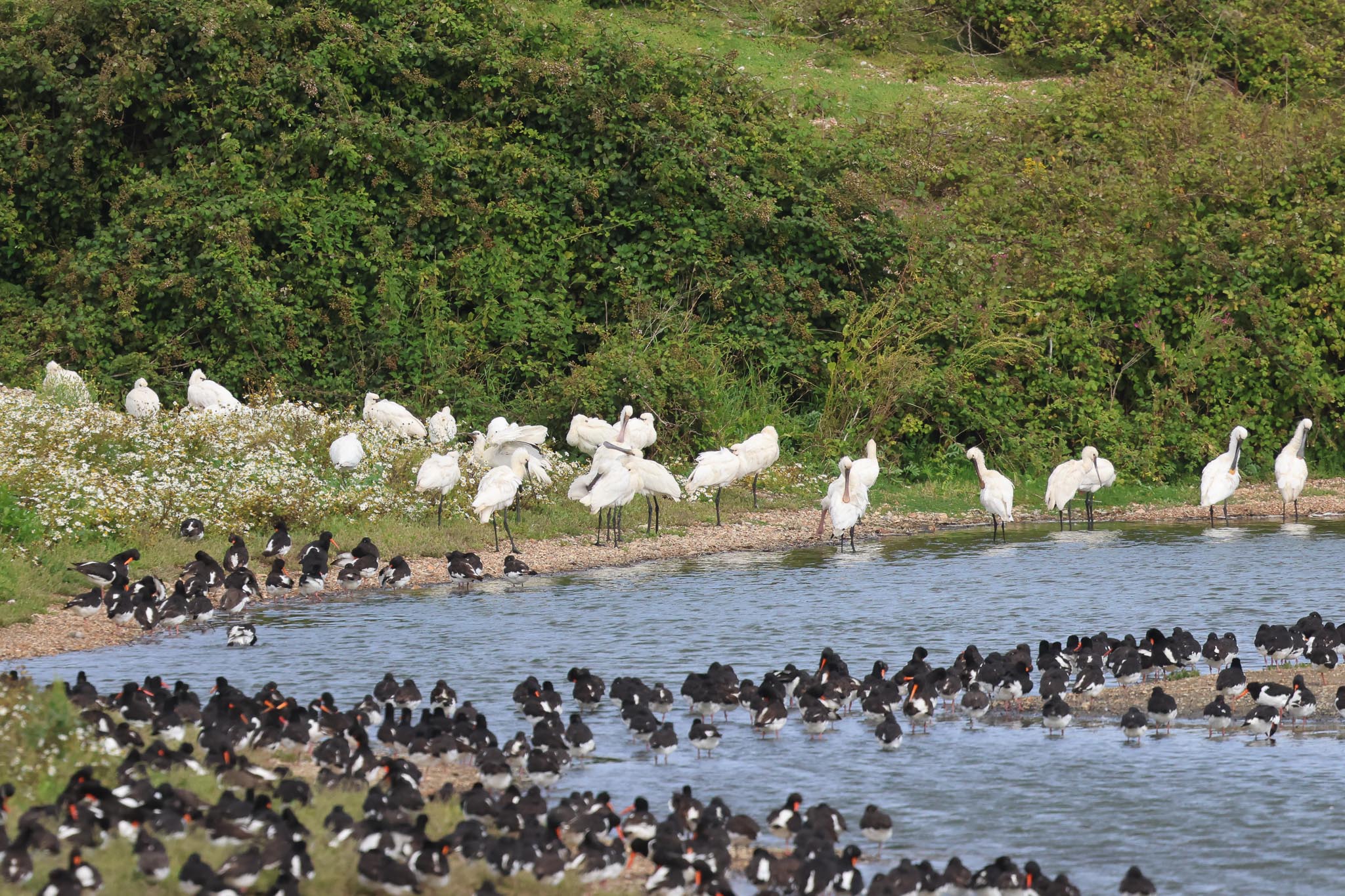
We went round to Knots Landing to check out the islands in front of there. Three or four Little Terns were dip feeding in front of the hide and more terns were loafing on one of the islands. We got them in the scope, again a mix of Sandwich, Common and Little Terns, but a closer (and less windy!), view than we had of them out on the Wash earlier. Something spooked the Spoonbills and they all flew across and landed on the bank on the other side.
There was the same mix of waders on the islands here, mainly Black-tailed Godwits, with a few Knot, Redshank and Dunlin in with them. A couple of Common Sandpipers were patrolling the shingle edges of the islands here too and one seemed to be defending a small stretch of shore, chasing off the other if it strayed onto its patch.
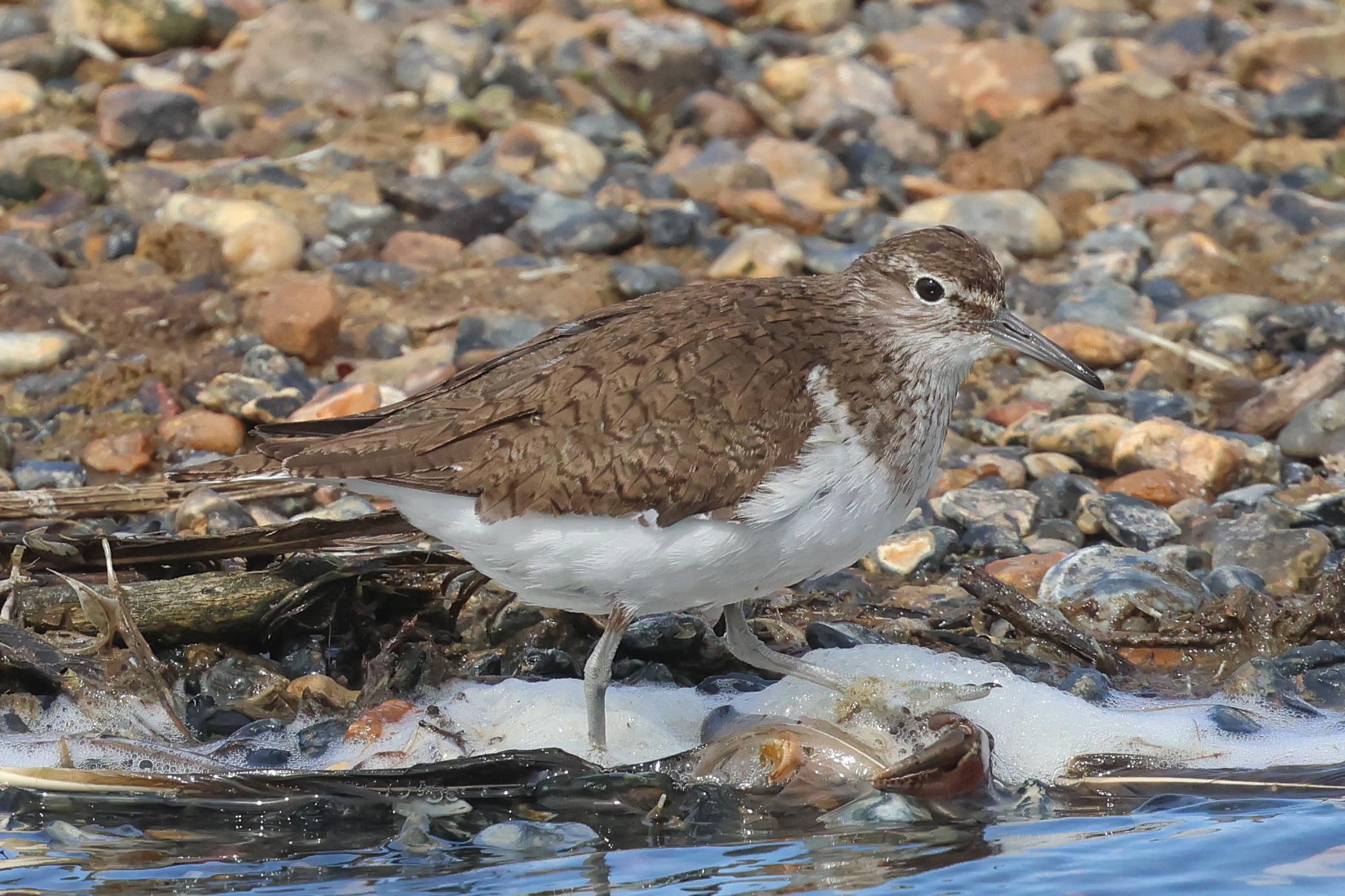
Looking over to Shore Hide, it looked like it had thinned out a bit, so we set off to walk round. We had a quick diversion back into South Screen where the warden kindly showed us the Red Hemp-nettle flowering on the shingle in between the Oystercatchers, a rare plant this is the only place it is found in Norfolk and it doesn’t sound like it is a good year for it this year. Then back out on the boardwalk, as we walked over the top, a very dark bird came in over the saltmarsh towards us, a dark phase adult Arctic Skua. It turned and headed back out again, then north along the shore, a very nice bonus blown into the Wash by the wind.
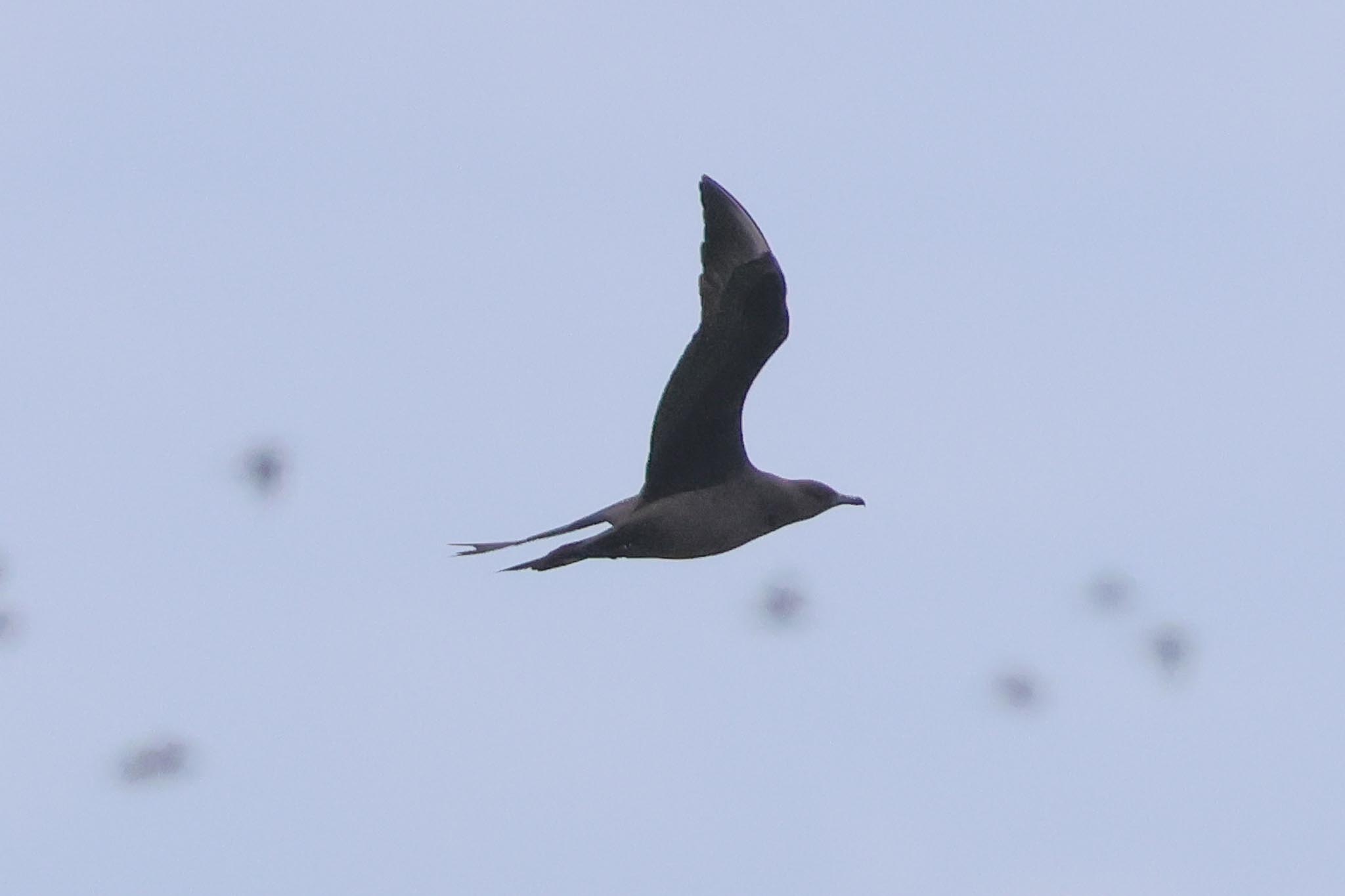
There were several Linnets bathing in a puddle on the path and a few Meadow Pipits around the edge too, which we stopped to look at. A line of Knot came up from the Pit and headed back out over the Wash, but the tide was slow to go out today and there was no mud exposed yet, so they turned and flew back in. When we got into Shore Hide, the corner overlooking the islands packed with Knot was still packed with toggers who had taken up residence, along with their packed lunches and flasks, waiting for the birds to fly, but there was plenty of room in the rest of the hide for us.
There were lots of Cormorants on the various clumps of rocks out in the middle of the water, and a roosting group of Redshanks in the middle of one of them. Through the scope, we could see several Spotted Redshanks in with them, mostly asleep but from time to time one would wake up and flash its longer needle-fine bill. We could see they were a paler shade of grey above too. Eventually we managed to get into the corner of the hide and get the scope on the island where all the Knot were packed in shoulder to shoulder.
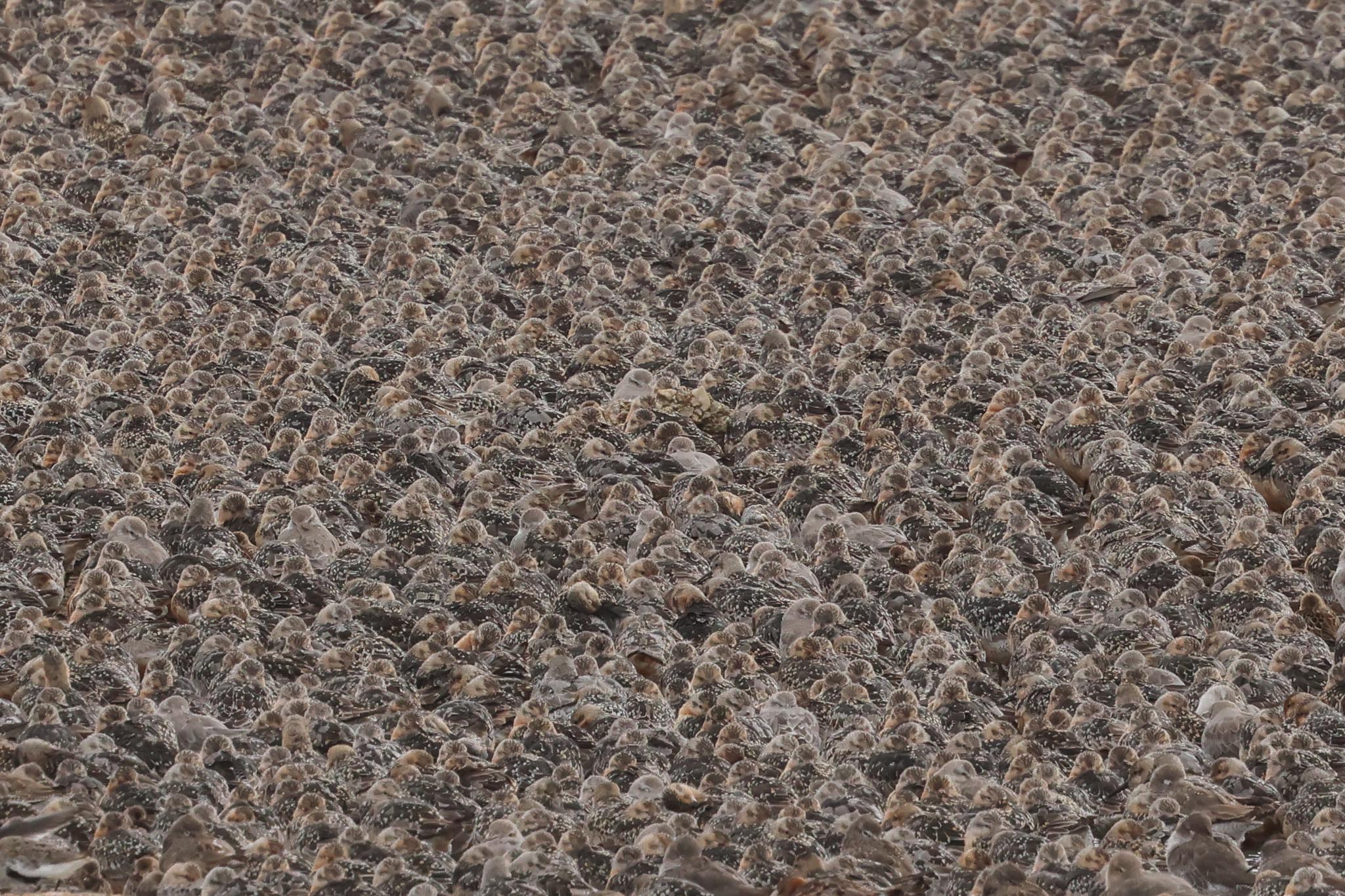
From time to time they would shuffle and a wave would go through them. A Moorhen walked through the middle of them too at one point, and the parted and left a clear patch in the middle for it. When something spooked all the birds on one of the islands further back, they whirled round over the Pit but it seemed like they quickly realised it was a false alarm. Most of the Knot dropped back in on the closer island now, pushing all the Dunlin off the edge nearest the bank.
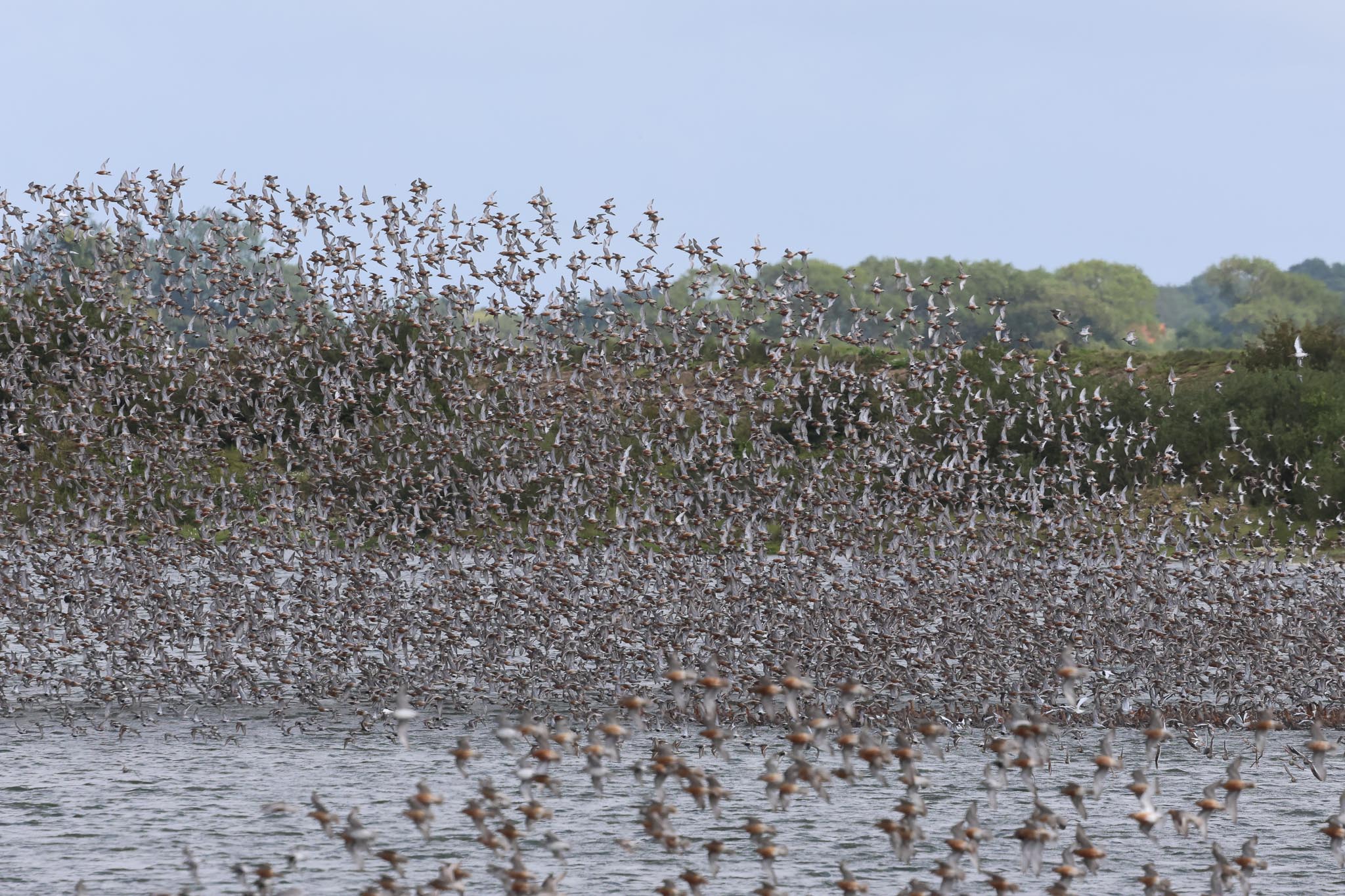
It was well beyond an hour after high tide now, but the mud was only just starting to reappear. The tide was being held in by the wind today, and it was slow to go back out, and the waders were showing no sign of moving yet too. There were dark clouds out over the Wash and it had started to spit with rain again, so we stayed in the hide for a bit before eventually, when the rain seemed to be blowing through, we went back out to check the Wash. Some of the Oystercatchers had gone back out already and spread out on the edge of the saltmarsh, and some Knot had reappeared back out on the mud but still tucked in the corner. A Spotted Redshank called and landed in the channel in front of us, swimming over to the far bank before walking up onto the mud and flying off, showing the lozenge of white up its back.
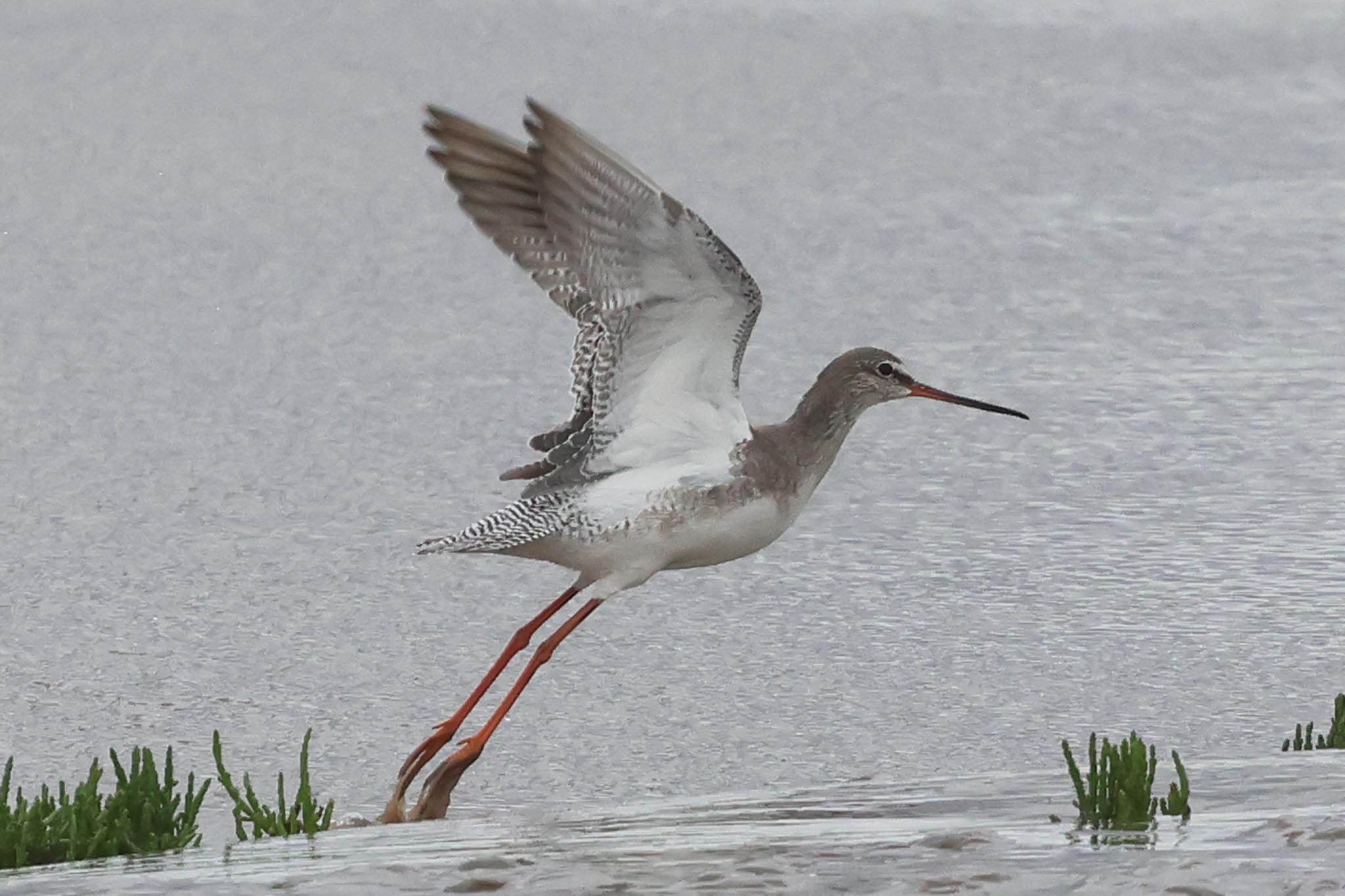
A few small wisps of waders started to come up over the bank from the Pit, but it didn’t seem like the bulk of the Knot were in any great hurry to return to the Wash. It was still spitting with rain, so we decided to start making our way slowly back. Up towards Rotary Hide, we stopped to watch a Hummingbird Hawkmoth flying back and forth over the path ahead of us. It landed briefly on a bramble bush next to the path – not really the weather for any self-respecting moths to be out!
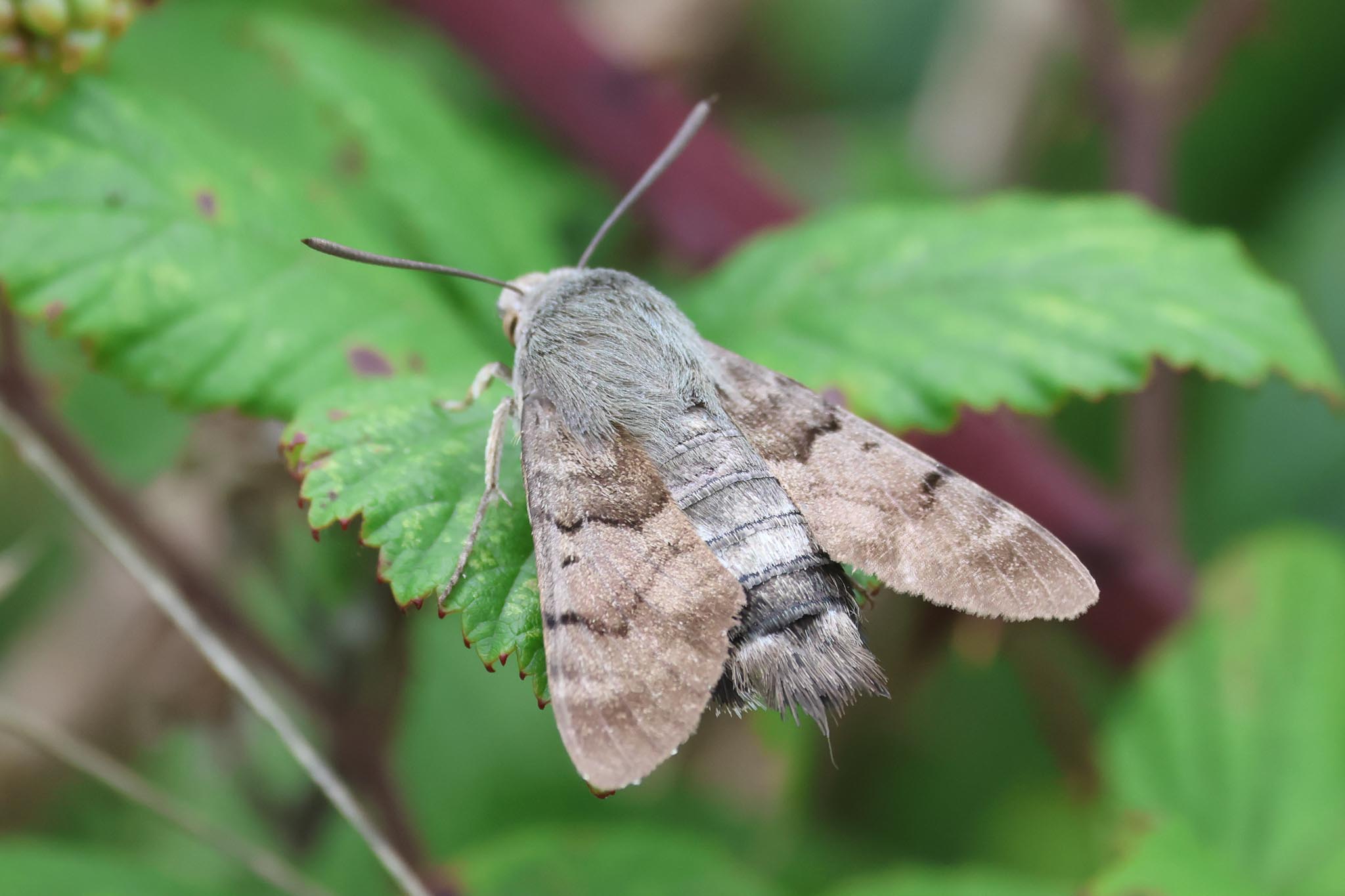
We made our way round to Titchwell next, and it was time for lunch by the time we arrived. The rain we had driven through on the way had cleared through and the sun had come back out, even if it was still a bit damp in the picnic area. After lunch, we headed out for a quick look around the reserve. Speaking to the staff at the Visitor Centre, there had been a Green Sandpiper at the end of the recently opened Autumn trail earlier, so we decided to head round that way first. A family of Long-tailed Tits were in the trees just beyond the Centre and there were a couple of Chaffinches and a few Blue Tits and Great Tits around the feeders.
We walked round on Fen Trail. A couple of Common Swifts were feeding out over the reeds north of Fen Hide along with a few House Martins. Out on the Tank Road, several Blackcaps flicked around in an elder bush and a Greenfinch flew out. There were more tits and a Chiffchaff calling in the trees just before the Patsy’s Reedbed viewpoint. We stopped here for a quick look. There were lots of Gadwall on the pool, along with a couple of Teal, a few Common Pochard and a couple of Tufted Ducks. A Little Grebe appeared from behind the reeds right at the front, followed by two small fluffy juveniles, which it proceeded to feed. There were a few Coot on here too.
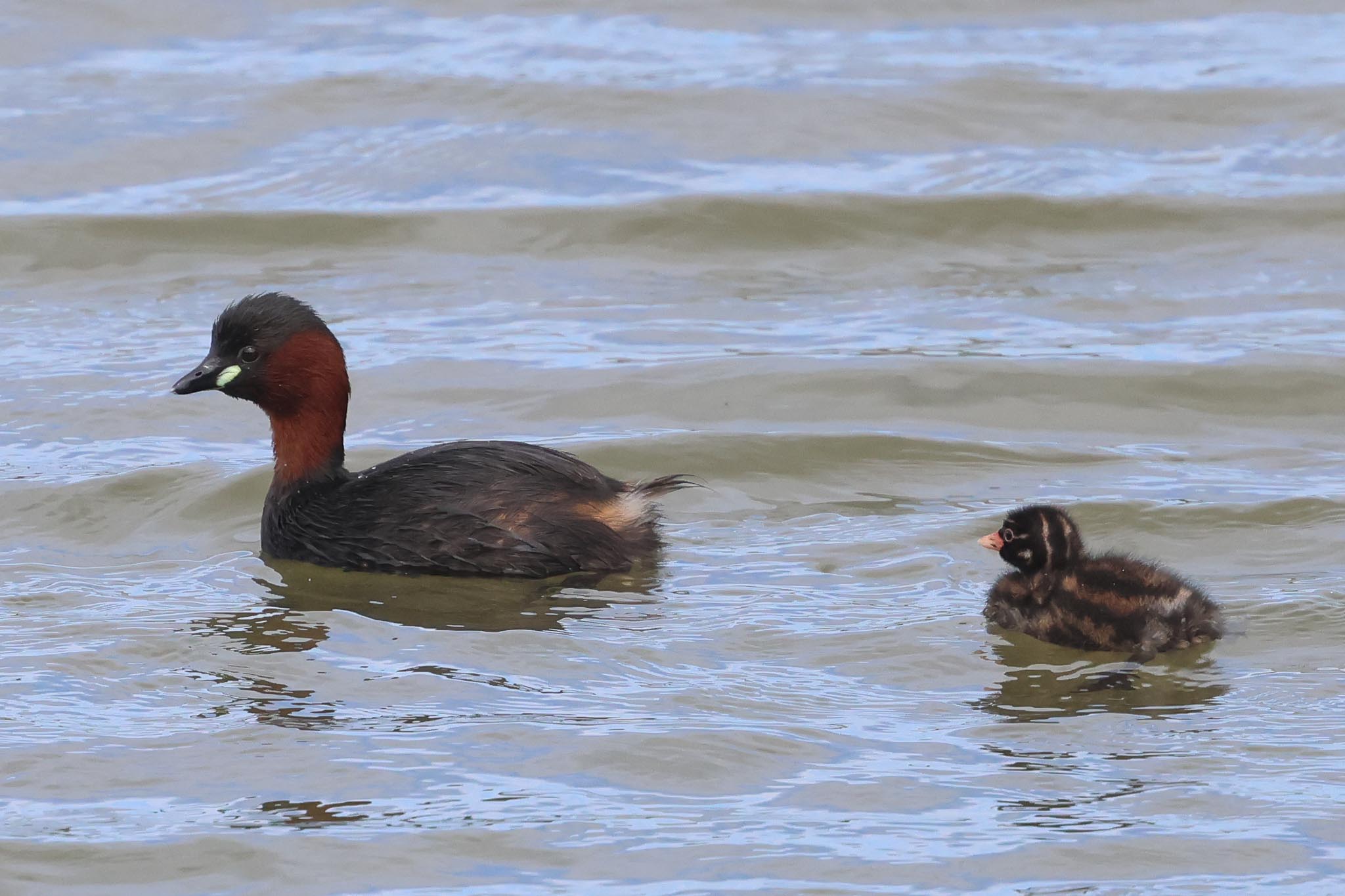
Down to the corner and a Sedge Warbler flicked up out of the sedges by the dragonfly pond. We had talked about eclipse plumage in ducks – none of the drakes are at their best at this time of year – and an eclipse drake Mallard was in the far corner of Patsy’s, so we could see its yellow bill. A fresh second generation Wall butterfly flew ahead of us and landed on the path.
When we got to the far end of the Autumn Trail it was a bit disappointing to find the water level so high there was no mud for any waders now. We could see some distant Golden Plover roosting on one of the islands tucked in out of the wind, but not much else of note, so we decided to head back round to the main West Bank path. It started to spit with rain again so we quickened our step to get out of the wind, but the worst of the rain was away to the west and whatever came our way quickly cleared through. As we walked out from the trees on the main path, a Common Frog was on the path ahead of us and needed to be encouraged to move out of the way of all the feet passing.

There were a couple of Shoveler in with the Gadwall on the main reedbed pool as we passed and five Spoonbills flew over and out over the Thornham saltmarsh. Several Reed Warblers flicked in and out of the reeds but it was a bit too windy for any Bearded Tits today.
We called in at Island Hide, where several Avocets were feeding up to their bellies in the water in front. There was not much mud for waders here either today, but we did find a couple of Ruff feeding along the bund to the north. Several Common Terns flew in and out calling, and one appeared still to have a juvenile tucked in the vegetation on one of the islands. A Chinese Water Deer ran along the bund at the far side.

Back out on the main path, the sun was out again now (the weather couldn’t make up its mind this afternoon) and a Common Lizard was basking on the rail of the fence by the path.
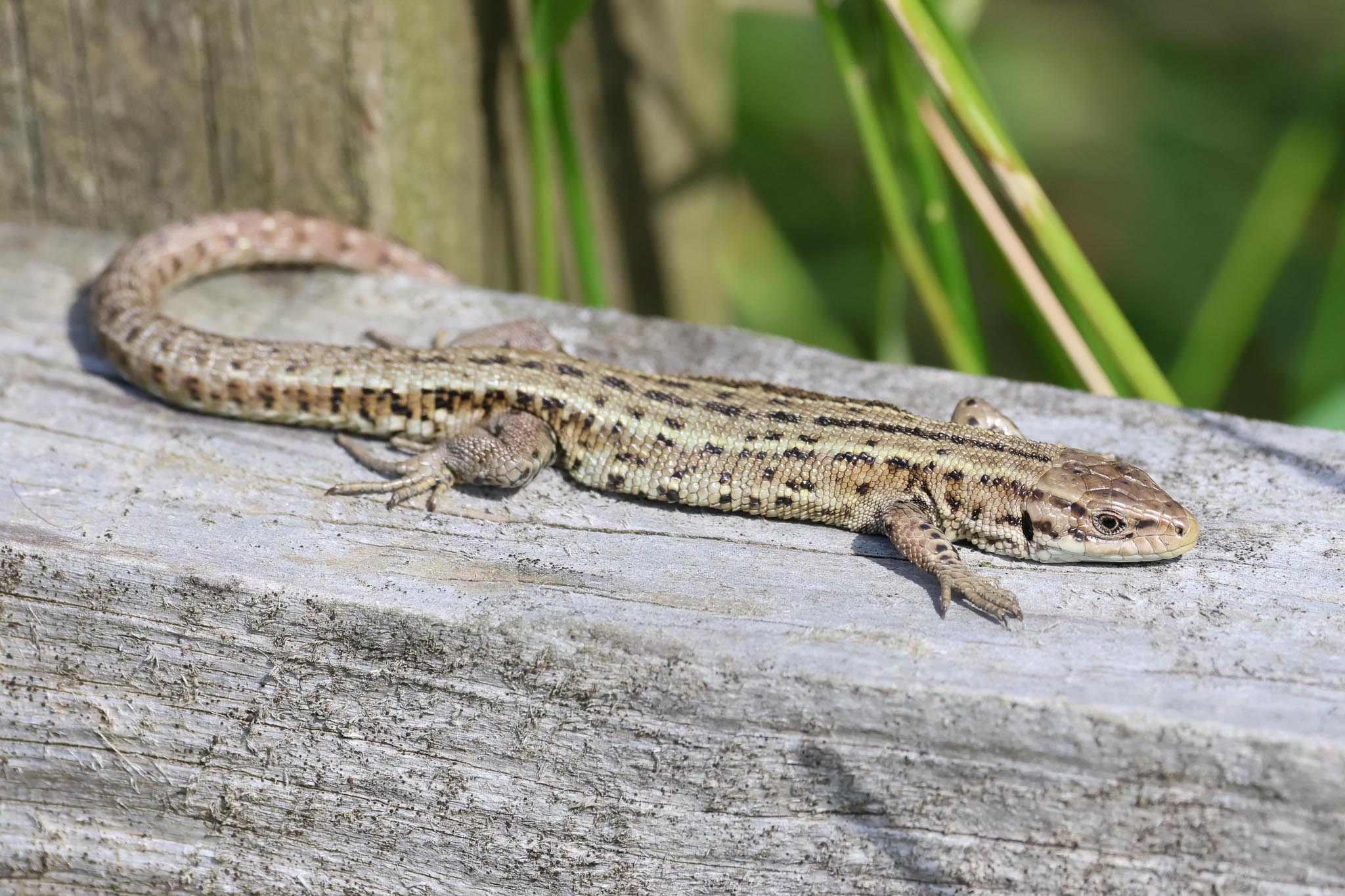
A Yellow Wagtail called and flew off behind us, then another flew round and landed on the bund briefly. We stopped on the bank to look at it, but it was intent on chasing a Meadow Pipit off and wouldn’t settle. There were a couple more Ruff on the next compartment but again not much mud here either to tempt in more small waders and consequently not much surprise there was no sign of the Green Sandpiper anywhere on the Freshmarsh this afternoon.
We were just about to walk on when we noticed a large gull which had just landed in the shallow water back on the other side of the bund. It was a juvenile Caspian Gull – we could see its long face and bill, rather pale headed already, and its black tertials with white thumbnail tips. There have been good numbers of them in Norfolk in the last couple of weeks, birds dispersing west from the colonies in Germany and Netherlands at the end of the breeding season. Another nice bonus.

We continued on round towards Parrinder Hide. One of the regular volunteers had told us there were some Wasp Spiders in the vegetation along the bank here and scanning carefully we found one as we walked along the path so we stopped to admire it. Large and boldly marked with yellow and black, they are quite a striking spider and only a recent colonist to this part of the UK.

There were a few more Ruff and several Lapwings on the grassy island in front of Parrinder Hide. We heard a Greenshank call a couple of times, but we couldn’t see it – there was nowhere obvious for it to drop in on the Freshmarsh, so presumably it was feeding in one of the channels on the back of the Volunteer Marsh.
We never have very long to spend here on Wader Spectacular days and we noticed now that time had run away from us and some of the group needed to get back. We had a quick look from the other side of Parrinder Hide – the Caspian Gull was now asleep on the compartment here and an adult Mediterranean Gull, in winter plumage already with black bandit mask rather than black hood, was loafing in with the Black-headed Gulls.
There was one last surprise for us today. As we drove back inland through Choseley we noticed a bird trying to balance on the wires by the road in the wind. As we pulled up to take a look, we could see it was a juvenile Cuckoo! It flew off across the field and into the trees beyond. A nice way to end.
















